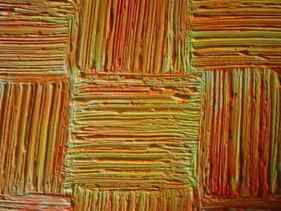Paint Mixing – Variety is a principal of art and a hallmark of texture. I try to show variety in a texture from the first brush stroke onward. When I mix colors for a textured subject, I do not completely mix the paint. This allows for some unplanned, random variance of color.
Create Paint Textures with Acrylics

Textured paintings could simply be defined as a finished paint product which has been combined with insoluble materials that give the overall product a slightly rough textural effect.

This texture in paintings helps heighten the artistic value of a particular art material because the application of texture in these art materials helps in stimulating our sense of sight and touch, and thus creating more value for that particular piece of art.
Also, the texture in the paint provides a dimension to the painting, giving the painting itself a vitality or life in the image itself. It’s easy to create paint textures using your acrylic since you could use almost any material to add texture to your work. There are conventional and non-conventional ways of creating texture with your paint while using acrylic.
Conventional way – Make use of chemical additives that provide texture to your paint.
Was this step helpful? Yes | No| I need help
Non-conventional way – Make use of day-to-day materials such as cardboard, thread, beads, coins, cotton, mesh wires, etc
Any material that has defined shape and texture may be used as part of the overall look of the painting.
Was this step helpful? Yes | No| I need help
Texturing your Paint: Conventional Way
Deciding on Your Base
When it comes to creating a paint texture with your acrylics, using white latex paint as a base would be the first priority. Applying a white latex paint on your canvas before using your colored paint on top of it will ensure a better quality in the output of your paintings.
Was this step helpful? Yes | No| I need help
Selecting Your Color
Before selecting the color of the paint that you wish to use, ensure that you would always opt for the color one shade darker than your desired color. Adding a texturing medium will lighten the color of the paint that you’ve chosen, so it is best to opt for the color one shade darker than preferred. In cases where you decide to directly texture your colored paint, having a test sample on another piece of art material will be a good way to test if the color has achieved your preferences.
Was this step helpful? Yes | No| I need help
Selecting the Texturing Medium
After deciding on the color of your paint, the next step would be considering the texturing medium that you will be mixing with your paint. There are a number of varieties available for your texture medium that you could use and as such includes the following:
- Pre-mixed
What Kind of Texture are We Talking About?
In terms of painting, texture refers to either the way something looks as if it may feel or to the actual surface of the paint. This article is about the former and not the later, although using brush strokes in relief can also add to the illusion of a subject’s texture.

Problems with Painting Texture
Some problems are fun to solve. Texture is one of those problems. Each texture is unique, requiring a fair measure of creativity to work through.
Painting texture is really about mark-making. The illusion of texture is created through a frequent alternation between light and dark marks.
The marks used to paint a wispy field of grass are different from those used to paint a rocky canyon wall. Each texture is its own painting experience, challenging even with the most practiced artist. The artist must find new ways to make marks for each texture. Some artists vary their hand motions with brushes to achieve the variety of marks needed to differentiate between textures. Other artists find or make painting tools that produce the character of marks they desired.
Most textures are represented through the application of an uncountable number of marks. Painting texture requires patience, time and a keen eye.
Approaches to Texture in Art History
Before the Twentieth Century, artists seem to fall into two general categories regarding texture. Some artists laboriously worked to capture observable textures through the application of many careful brush strokes. During the Northern Renaissance, artists like Albrecht Durer painted textured surfaces one stroke at a time. In Durer’s Self-Portrait, he first painted the hair a general color. Then he worked in layers, alternating between lighter and darker strokes, until finally reaching the desired complexity of texture. No part of the hair is spared from Durer’s relentless rendering of texture.

Contrarily, Caravaggio, an Italian Master from the Baroque period only suggested texture when necessary, instead focusing on form and color to bring his subjects to life. In The Lute Player, Caravaggio uses only a few strokes to suggest the texture of hair. The entire right half of the hair is just a solid color.






